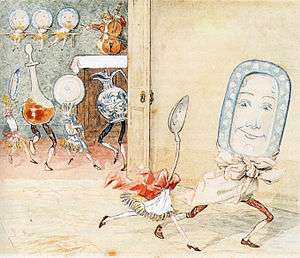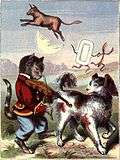Hey Diddle Diddle
| "Hey Diddle Diddle" | |
|---|---|
| Roud #19478 | |
 The Cow jumped over the moon, according to William Wallace Denslow | |
| Song | |
| Written | England |
| Published | c. 1765 |
| Form | Nursery rhyme |
| Writer(s) | Traditional |
| Language | English |

"Hey Diddle Diddle" (also "Hi Diddle Diddle", "The Cat and the Fiddle", or "The Cow Jumped Over the Moon") is an English nursery rhyme. It has a Roud Folk Song Index number of 19478.[1]
Lyrics
A common modern version of the rhyme is:
Hey diddle diddle,
The cat and the fiddle,
The cow jumped over the moon.
The little dog laughed,
To see such sport,
And the dish ran away with the spoon.[1]
- ^ I. Opie and P. Opie, The Oxford Dictionary of Nursery Rhymes (Oxford University Press, 1951, 2nd edn., 1997), pp. 203–4.
Origins
The rhyme may date back to at least the sixteenth century. There is a reference in Thomas Preston's play A lamentable tragedy mixed ful of pleasant mirth, conteyning the life of Cambises King of Percia, printed in 1569 that may refer to the rhyme:
They be at hand Sir with stick and fidle;
They can play a new dance called hey-didle-didle.[1]
- ^ I. Opie and P. Opie, The Oxford Dictionary of Nursery Rhymes (Oxford University Press, 1951, 2nd edn., 1997), pp. 203–4.
Another possible reference is in Alexander Montgomerie's The Cherry and the Slae from 1597:
But since you think't an easy thing
To mount above the moon,
Of your own fiddle take a spring
And dance when you have done.[1]
- ^ C. R. Wilson and M. Calore, Music in Shakespeare: a Dictionary (London: Continuum, 2005), ISBN 0826478468, p. 171.
The name "Cat and the Fiddle" was a common name for inns, including one known to have been at Old Chaunge, London by 1587.[2]
The earliest recorded version of the poem resembling the modern form was printed around 1765 in London in Mother Goose's Melody with the lyrics:
Hey diddle diddle,
The Cat and the Fiddle,
The Cow jump'd over the Moon,
The little dog laugh'd to see such Craft,
And the Dish ran away with the Spoon.[1]
- ^ Cite error: The named reference
Opie1997was invoked but never defined (see the help page).
Meaning
There are numerous theories about the origin of the rhyme, including: James Orchard Halliwell's suggestion that it was a corruption of ancient Greek, probably advanced as a result of a deliberate hoax; that it was connected with Hathor worship; that it refers to various constellations (Taurus, Canis Minor, etc.); that it describes the Flight from Egypt; that it depicts Elizabeth, Lady Katherine Grey, and her relationships with the earls of Hertford and Leicester; that it deals with anti-clerical feeling over injunctions by Catholic priests for harder work; that it describes Katherine of Aragon (Katherine la Fidèle); Catherine, the wife of Peter the Great; Canton de Fidèle, a supposed governor of Calais and the game of cat (trap-ball).[3] This profusion of unsupported explanations was satirised by J.R.R. Tolkien in his fictional explanations of 'The Man in the Moon Stayed Up Too Late'.[4] Most scholarly commentators consider these to be unproven and state that the verse is probably meant to be simply nonsense.[3]
Melody
The melody commonly associated with the rhyme was first recorded by the composer and nursery rhyme collector James William Elliott in his National Nursery Rhymes and Nursery Songs (1870).[5]
Adaptations
- 1978 Soviet animated film "A Fantastic Tale" (Russian: Чудеса в решете) by Andrei Khrzhanovsky, based on translation of Samuil Marshak.[6]
- Hey Diddle Diddle was featured in Jim Henson's Mother Goose Stories.
- Hey Diddle Diddle Right Up the Middle, a slang term for a military strategy of frontal assault
- Hey Diddle Diddle Ray Rice up the middle.
- A version of Hey Diddle Diddle was featured in J.R.R. Tolkien's Lord of the Rings.
- The Black Sabbath song Supernaut from Vol. 4 mentions being on the moon and looking for the dish that ran away with the spoon
- It features in a reggae song by Sylford Walker – "What a Lie".
- The illustration appeared as a backdrop when Dennis Hopper was offered a cup of coffee by Luana Anders at a merry-go-round in the 1961 movie Night Tide.
- In the musical Rent, the character Maureen sings a version of the rhyme, entitled "Over The Moon".
- In the animated movie Shaun the Sheep Movie, an homage to the nursery rhyme is shown in one scene.
- In the animated series American Dad! Season 7 episode 6 There Will Be Bad Blood a cow is seen jumping over the moon only to fall to Earth near the end.
Notes
- ↑ "Roud Folksong Index S298441 Sing hey diddle diddle, the cat and the fiddle". Vaughan Williams Memorial Library. English Folk Dance and Song Society. Retrieved May 20, 2016.
- ↑
- 1 2
- ↑ S. H. Gale, Encyclopedia of British Humorists: Geoffrey Chaucer to John Cleese (London: Taylor & Francis, 1996), p. 1127.
- ↑ J. J. Fuld, The Book of World-Famous Music: Classical, Popular, and Folk (Courier Dover Publications, 5th edn., 2000), ISBN 0486414752, p. 502.
- ↑ Animator.ru: «A FANTASTIC TALE»
